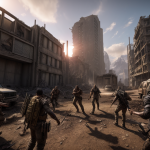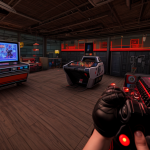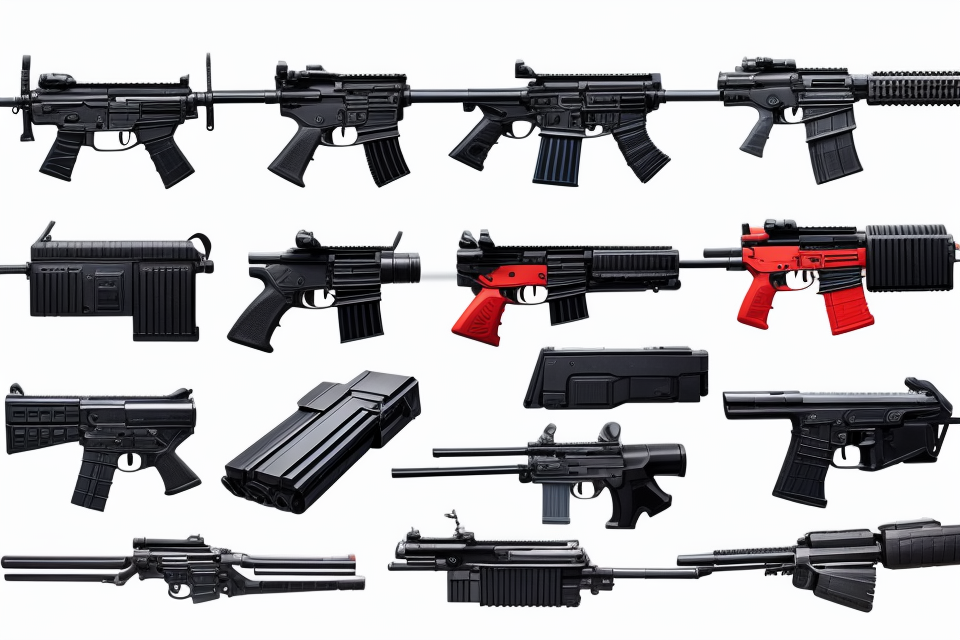Get ready to aim, fire, and conquer in the world of shooter games! From classic arcade games to immersive first-person shooters, shooter games have come a long way since their inception. But what exactly do we call these games? In this comprehensive guide, we’ll explore the different types of shooting games and the various terms used to describe them. Get ready to expand your gaming vocabulary and discover the thrilling world of shooter games!
What are Shooter Games?
Definition of Shooter Games
Shooter games are a subgenre of video games that primarily involve shooting as the central gameplay mechanic. These games are often characterized by fast-paced, action-packed gameplay, where players must use weapons to defeat enemies or targets. The shooting mechanics in these games can vary widely, from first-person shooters (FPS) to third-person shooters (TPS) and even rail shooters, where the player’s movement is limited to a predetermined path.
In shooter games, players typically control a character or avatar that can wield a variety of weapons, including firearms, explosives, and even melee weapons. The objectives of these games can also vary widely, from completing specific tasks or missions to simply surviving against waves of enemies.
One of the defining features of shooter games is their focus on precision and accuracy. Players must be skilled at aiming and shooting in order to succeed, and many games include features like crosshairs, scopes, and aiming mechanics to help players line up their shots. Additionally, shooter games often include elements of strategy and tactics, as players must consider factors like ammo conservation, cover, and enemy placement in order to succeed.
Overall, shooter games are a popular and diverse genre of video games that offer players a thrilling and challenging experience. Whether players enjoy the fast-paced action of FPS games or the strategic gameplay of TPS games, there is a shooter game out there for everyone.
Brief History of Shooter Games
Shooter games have been a staple of the gaming industry for decades, with the first shooter game dating back to the early 1970s. Since then, the genre has evolved and expanded to include a wide variety of sub-genres, each with its own unique gameplay mechanics and styles.
In the early days of video games, shooter games were relatively simple affairs, with basic graphics and gameplay mechanics. However, as technology advanced and gaming became more popular, shooter games became more complex and sophisticated. Today, there are countless shooter games available across a variety of platforms, each offering its own unique take on the genre.
One of the earliest and most influential shooter games was the 1972 game “Spacewar!” which was developed for the PDP-1 computer. This game featured two players controlling spaceships and attempting to destroy each other using missiles. While it was a simple game by today’s standards, it laid the groundwork for the shooter genre and inspired many of the games that followed.
In the 1980s, shooter games began to evolve and became more popular with the release of games like “Galaga” and “Space Invaders.” These games introduced new gameplay mechanics, such as power-ups and enemy waves, and helped to establish the shooter genre as a staple of the gaming industry.
As technology continued to advance, shooter games became more complex and immersive. Games like “Doom” and “Quake” introduced first-person perspectives and advanced graphics, while games like “Halo” and “Call of Duty” introduced multiplayer modes and online play. Today, shooter games are one of the most popular genres in gaming, with millions of players worldwide.
Types of Shooter Games
First-Person Shooter (FPS) Games
Characteristics of FPS Games
First-Person Shooter (FPS) games are a subgenre of shooting games that are characterized by their use of a first-person perspective. In these games, the player assumes the role of a shooter, and the game’s camera is positioned behind the character’s eyes, providing a view of the game world through the character’s perspective.
Another key characteristic of FPS games is their focus on fast-paced, action-packed gameplay. These games often involve intense combat scenarios, in which the player must engage in battles with enemies using a variety of weapons and tactics. Many FPS games also include elements of exploration, as players must navigate complex environments and search for clues or items to progress through the game.
Examples of FPS Games
There are many popular examples of FPS games, including:
- Doom: Released in 1993, Doom is considered one of the first true FPS games. The game follows the player as they navigate a series of maze-like levels, battling a variety of monsters and demons.
- Half-Life: This series of games, which began in 1998, follows the adventures of scientist Gordon Freeman as he battles aliens and other hostile creatures.
- Call of Duty: This popular franchise, which debuted in 2003, is known for its realistic portrayal of modern warfare. Players can choose to play as soldiers from a variety of countries, and can engage in battles on land, sea, and air.
- Battlefield: This series, which debuted in 2002, is known for its large-scale, team-based gameplay. Players can choose to play as soldiers from a variety of countries, and can engage in battles on land, sea, and air.
- Destiny: Released in 2014, Destiny is a massively multiplayer online first-person shooter set in a science fiction world. Players can choose to play as a variety of characters, each with their own unique abilities and weapons.
Third-Person Shooter (TPS) Games
Characteristics of TPS Games
Third-person shooter games, often abbreviated as TPS, are a subgenre of shooting games that are characterized by their camera perspective. In TPS games, the player sees the game world from a position behind the character they control, and the character’s movements and actions are controlled by the player.
One of the key characteristics of TPS games is the emphasis on action and fast-paced gameplay. These games often feature a wide variety of weapons and upgrades, allowing players to customize their character’s arsenal to suit their preferred playstyle. TPS games also often feature open-ended levels, allowing players to explore and tackle objectives in any order they choose.
Examples of TPS Games
There are many popular TPS games across a variety of platforms, including:
- Grand Theft Auto series: This series of open-world action games features a large variety of weapons and vehicles, as well as a strong emphasis on exploration and player choice.
- Assassin’s Creed series: These action-adventure games feature a mix of stealth and combat gameplay, with players controlling a character who can wield a variety of weapons and perform acrobatic maneuvers.
- Tom Clancy’s Splinter Cell series: These stealth-based action games feature a character who can sneak around levels, avoid detection, and take out enemies with a variety of gadgets and weapons.
- Wolfenstein series: These first-person shooters feature fast-paced, violent gameplay, with players taking on the role of a protagonist fighting against Nazi and other evil forces.
- Gears of War series: These third-person shooters are known for their cover-based gameplay, which encourages players to use the environment to their advantage in combat.
Overall, TPS games offer a wide variety of gameplay experiences, from open-world exploration to fast-paced combat, and are a popular subgenre of shooting games.
Shoot ‘Em Up (SHMUP) Games
Characteristics of SHMUP Games
Shoot ‘Em Up (SHMUP) games, also known as “shmups,” are a subgenre of shooter games that typically involve the player controlling a character or vehicle that moves horizontally across the screen, while shooting enemies that appear from the side or from above. SHMUP games are often characterized by their fast-paced gameplay, intense action, and simple yet addictive mechanics.
One of the defining characteristics of SHMUP games is their focus on scoring. Players typically earn points by defeating enemies, and the more enemies they defeat in a single shot or within a short period of time, the more points they earn. The high score is often a key aspect of the game, and players often compete with each other to see who can achieve the highest score.
Another characteristic of SHMUP games is their emphasis on memorization and skill. Many SHMUP games have levels that are divided into stages, and each stage has its own unique pattern of enemy behavior and attacks. To be successful in these games, players must memorize the patterns and develop the necessary skills to navigate through them as efficiently as possible.
Examples of SHMUP Games
Some examples of popular SHMUP games include:
- “Space Invaders” (1978)
- “Galaga” (1981)
- “R-Type” (1987)
- “Gradius” (1985)
- “Contra” (1987)
- “Battle Garegga” (1996)
- “Ikaruga” (2001)
- “Bullet Hell” (2006)
- “Raizing’s Hero” (2013)
- “Darius Burst: Another Chronicle” (2017)
These games are often cited as classics of the genre and have influenced many of the modern SHMUP games that are still being developed today.
Light Gun Shooter Games
Characteristics of Light Gun Shooter Games
Light gun shooter games are a subgenre of shooting games that are typically played on a home console or arcade machine. These games are designed to be played with a light gun or rifle controller, which is often shaped like a real firearm. The player’s objective is to shoot targets on the screen, often while navigating a character through a series of levels or stages.
One of the defining characteristics of light gun shooter games is their focus on accuracy and timing. Successful play requires the player to aim and shoot accurately, often under time pressure or while navigating challenging terrain. The genre also tends to emphasize score-based gameplay, with players competing to rack up the highest scores possible.
Examples of Light Gun Shooter Games
Some popular examples of light gun shooter games include:
- “House of the Dead” series
- “Time Crisis” series
- “Virtua Cop” series
- “Gunblade” series
- “Duck Hunt” (NES)
These games often feature a first-person perspective, with the player’s character or avatar displayed on the screen. They may also feature a variety of enemies and obstacles to overcome, such as zombies, aliens, or obstacles that can block the player’s line of sight.
RPG Shooter Games
Characteristics of RPG Shooter Games
RPG shooter games, also known as role-playing games, are a subgenre of shooting games that combine elements of both first-person shooters and role-playing games. These games typically feature a character with a unique set of abilities and weapons, which the player can upgrade and customize throughout the game. The player often has the ability to choose their own path, make decisions that affect the outcome of the game, and interact with other characters in the game world.
One of the key characteristics of RPG shooter games is their emphasis on storytelling and character development. These games often have a complex narrative that unfolds over the course of the game, with branching paths and multiple endings. The player’s choices and actions can have a significant impact on the story and the outcome of the game.
Another characteristic of RPG shooter games is their focus on exploration and discovery. These games often have large, open worlds that the player can explore at their leisure, with hidden treasures, side quests, and other secrets to uncover. The player may also encounter non-playable characters (NPCs) who can provide information, assistance, or even become party members.
Examples of RPG Shooter Games
There are many examples of RPG shooter games, but some of the most popular include:
- Fallout: This series of games is set in a post-apocalyptic world, where the player must scavenge for resources and battle mutants and raiders to survive. The player can choose their own path and make decisions that affect the outcome of the game.
- The Elder Scrolls: This series of games is set in a vast, open world filled with mythical creatures and ancient ruins. The player can choose their own path and explore the world at their leisure, encountering NPCs and completing quests along the way.
- Deus Ex: This series of games is set in a dystopian future, where the player must navigate a complex web of conspiracies and secret societies. The player can choose their own path and make decisions that affect the outcome of the game, and can upgrade their character’s abilities and weapons throughout the game.
Simulation Shooter Games
Characteristics of Simulation Shooter Games
Simulation shooter games are a subgenre of shooting games that focus on creating a realistic and immersive experience for the player. These games typically feature detailed graphics, realistic weaponry, and a high level of accuracy in terms of how weapons handle and perform. They also often include realistic ballistics and recoil, which adds an extra layer of realism to the gameplay.
Another key characteristic of simulation shooter games is their attention to detail when it comes to the environments in which the games take place. These games often feature realistic landscapes, buildings, and other elements that are meant to mimic real-world settings. This attention to detail helps to create a more immersive experience for the player, as they feel like they are really in the game world.
Examples of Simulation Shooter Games
There are many examples of simulation shooter games that have been released over the years. Some of the most popular include:
- Call of Duty: Modern Warfare
- Battlefield
- Insurgency: Sandstorm
- Rainbow Six Siege
- Escape from Tarkov
These games all feature realistic weaponry, environments, and gameplay mechanics that are designed to create a truly immersive and realistic experience for the player. Whether you’re a fan of first-person shooters or just looking for a more realistic gaming experience, simulation shooter games are definitely worth checking out.
Shooter Games on Mobile Devices
Shooter games on mobile devices are a subgenre of video games that are specifically designed to be played on smartphones or tablets. These games are characterized by their simple controls, short play sessions, and addictive gameplay mechanics.
Characteristics of Mobile Shooter Games
Mobile shooter games are designed to be played on the go, making them accessible to players who want to play on their mobile devices. Some of the key characteristics of mobile shooter games include:
- Simple controls: Mobile shooter games have simple controls that are easy to learn and use, making them accessible to players of all skill levels.
- Short play sessions: Mobile shooter games are designed to be played in short bursts, making them ideal for players who have limited time to play.
- Addictive gameplay mechanics: Mobile shooter games often use addictive gameplay mechanics, such as rewarding players with in-game items or unlocking new levels, to keep players engaged.
Examples of Mobile Shooter Games
There are many mobile shooter games available, ranging from first-person shooters to top-down shooters. Some examples of popular mobile shooter games include:
- Fortnite: Fortnite is a popular battle royale game that is available on mobile devices. Players can team up with friends or compete against other players in intense matches.
- Call of Duty: Mobile: Call of Duty: Mobile is a first-person shooter game that is based on the popular console and PC game series. Players can choose from a variety of weapons and play modes, including multiplayer matches and battle royale games.
- Dead Effect 2: Dead Effect 2 is a first-person shooter game that is set in a sci-fi universe. Players can fight against hordes of zombies and other monsters using a variety of weapons and abilities.
Overall, mobile shooter games are a popular subgenre of video games that offer players a unique gaming experience on their mobile devices.
Recap of Shooter Game Types
- Shooter games are a subgenre of video games that involve the use of firearms or other weapons to defeat enemies.
- The genre is often divided into several subcategories, including first-person shooters, third-person shooters, and tactical shooters.
- First-person shooters (FPS) are games where the player sees the action through the eyes of the character they are controlling.
- Third-person shooters (TPS) allow the player to see their character and the environment around them.
- Tactical shooters focus on realism and emphasize strategy and teamwork.
- Other subcategories include run-and-gun games, shoot ’em up games, and sniper games.
- The choice of subcategory often depends on the player’s preference for gameplay style and level of realism.
Future of Shooter Games
As technology continues to advance, the future of shooter games is poised for exciting developments. With virtual reality (VR) and augmented reality (AR) technologies becoming more accessible, players can expect an increasingly immersive gaming experience.
One major trend in the future of shooter games is the integration of real-time physics simulations. This means that players will have to account for factors such as gravity, wind, and ballistics when aiming and shooting. This added layer of realism will make the gaming experience more challenging and exciting.
Another trend is the growth of competitive shooter games, which are already popular on a professional level. These games will continue to evolve, with more complex strategies and tactics emerging as players hone their skills. Additionally, esports leagues for shooter games are expected to grow, attracting even more players and viewers.
Another development to watch for is the increased use of machine learning and artificial intelligence (AI) in shooter games. AI can be used to create more intelligent non-player characters (NPCs) that adapt to the player’s style of play, as well as to generate more realistic and varied game environments.
In summary, the future of shooter games looks bright, with advancements in technology and gaming trends leading to an increasingly immersive and competitive experience for players.
FAQs
1. What are shooter games?
Shooter games are a subgenre of video games that primarily involve the use of firearms or other projectile weapons. Players often take on the role of a character who must eliminate enemies or complete objectives by using various weapons. Shooter games can be divided into several subcategories, including first-person shooters, third-person shooters, and light-gun shooters.
2. What is the difference between first-person shooters and third-person shooters?
In a first-person shooter, the player sees the game through the eyes of their character and controls their movements and actions directly. In a third-person shooter, the player can see their character as well as the environment around them, and the character is controlled through a combination of direct input and context-sensitive actions.
3. What is a light-gun shooter?
A light-gun shooter is a type of shooter game that is played using a special controller designed to resemble a gun. Players aim and shoot at targets on the screen by pressing a button when the crosshair on the controller aligns with the target. Light-gun shooters are often arcade games or are played on dedicated consoles.
4. What are some popular examples of shooter games?
There are many popular shooter games, including Halo, Call of Duty, and Fortnite. These games have millions of players worldwide and are known for their fast-paced gameplay and competitive multiplayer modes. Other popular shooter games include Doom, Battlefield, and Resident Evil.
5. Are shooter games violent?
Shooter games can be violent, as they often involve characters using firearms to kill enemies. However, it is important to note that the level of violence in shooter games can vary greatly, and some games may be more violent than others. It is up to individual players to decide whether or not they want to play violent games, and parents should consider the age and maturity level of their children before allowing them to play shooter games.









